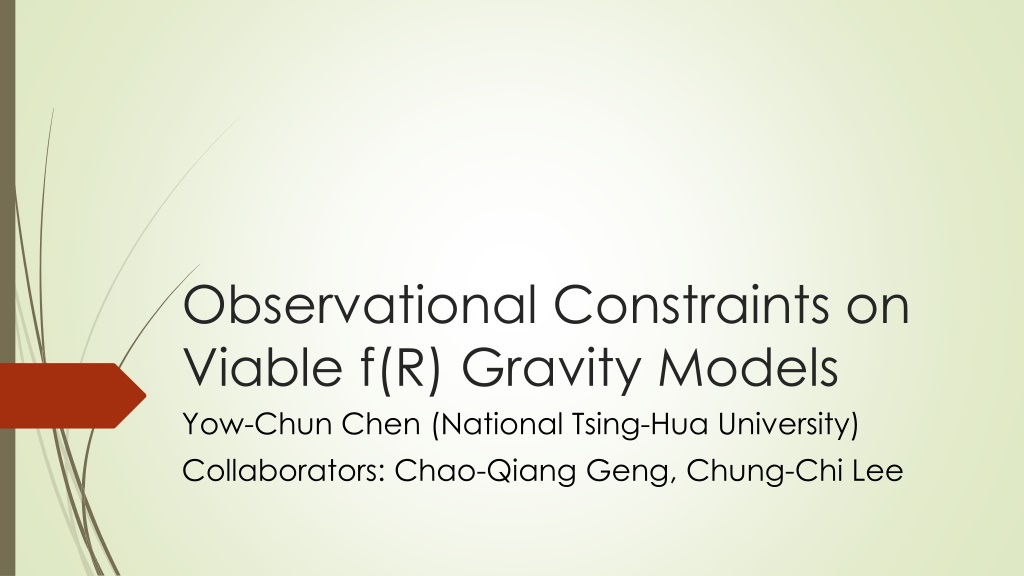Observational Constraints on Viable f(R) Gravity Models Analysis
Investigating f(R) gravity models by extending the Einstein-Hilbert action with an arbitrary function f(R). Conditions for viable models include positive gravitational constants, stable cosmological perturbations, asymptotic behavior towards the ΛCDM model, stability of late-time de Sitter point, and passing local system constraints. Various viable f(R) gravity models such as Exponential, Tsujikawa, Starobinsky, and Hu-Sawicki are explored. Background evolution equations and observational data from CAMB, MGCAMB, CosmoMC, BAO (baryon acoustic oscillations), Planck 2015, and SNLS (Supernova Legacy Survey) are analyzed to constrain these models.
Download Presentation

Please find below an Image/Link to download the presentation.
The content on the website is provided AS IS for your information and personal use only. It may not be sold, licensed, or shared on other websites without obtaining consent from the author. Download presentation by click this link. If you encounter any issues during the download, it is possible that the publisher has removed the file from their server.
E N D
Presentation Transcript
Observational Constraints on Viable f(R) Gravity Models Yow-Chun Chen (National Tsing-Hua University) Collaborators: Chao-Qiang Geng, Chung-Chi Lee
Outline f(R) gravity Viable f(R) gravity models Observational Constraints on Viable f(R) Gravity Models
f(R) gravity In f(R) gravity, the Ricci scalar R in the Einstein-Hilbert action is extended to an arbitrary function f(R). Modified Einstein-Hilbert action: ? = 4? ?? ? 16??+ ?? Taking variation of the action with resect to ???, we get the modified Einstein equation: ? 1 2?????? ? + ?????? ??? ??, and ???= ??? 1 ?????= 2??? where ?? ? ? 2???? ?
Conditions for viable f(R) gravity model 1. Possess positive effective gravitational constants and exhibit stable cosmological perturbations: > 0 and 2? ? ? ? ? ?2> 0 for ? ?0 2. Asymptotic behavior to the ?CDM model in the large curvature regime: ? ? ? 2? for ? ?0 3. Presence Stability of the late-time de Sitter point 4. Passing the local system constraints
Viable f(R) Gravity Models Exponential gravity model: ? ? 1 ? ?? ? ? = ? ??? Tsujikawa model: ? ?tanh ? ? = ? ??? ? ?? Starobinsky model: ? ?2 ?2 ? ? ? = ? ??? 1 1 + ?? Hu-Sawicki model: ? ?? ?1 ? ?? ?? ? ? = ? ?? ? ?? ?2 ? ?? + 1
Background Evolution By the continuity equation: ???+ 3? 1 + ??????= 0 we can derive the equation of state for dark energy: ??? ??? ??? where the introduced variables: = 1 1 1 ?? ln? 3 ?? ?2 ?2 ? 3 ?? 4, ??= ?? ??? ? ?2 3? 3 0= ?? with: 0 0 ?2 ?2?? , ? ?? 0 3 ??
Observational data Code utilized: CAMB and MGCAMB CosmoMC: Markov-Chain Monte-Carlo Data utilized: BAO (baryon acoustic oscillations) data Planck 2015 likelihoods SNLS (Supernova Legacy Survey) data
Observational Constraints on Viable f(R) Gravity Models Tsujikawa ?CDM model Exponential
Observational Constraints on Viable f(R) Gravity Models Starobinsky (n = 1) Starobinsky (n = 2)
Observational Constraints on Viable f(R) Gravity Models Hu-Sawicki (p = 2) Hu-Sawicki (p = 4)
Observational Constraints on Viable f(R) Gravity Models ?CDM background Allowed regions:1 ? (68%) confidence level for model parameter 2 ? (95%) confidence level for the rest Parameter ?CD M Exponential 100?? 2 2.23 0.03 2.23 0.03 ?? 2 0.118 0.002 0.118 0.002 ??? < 0.20 eV < 0.21 eV model parameter 0.651 0.129 Best fit ?2 13459.3 13457.6 Tsujikawa 2.23 0.03 0.118 0.002 < 0.18 eV Starobinsky (n=1) +0.03 2.23 0.02 0.117 0.002 < 0.25 eV +0.003 +0.290 +0.315 +0.154 0.685 0.064 13457.0 0.377 0.260 13457.7 Parameter ?? 2 ?? 2 ??? model parameter Starobinsky (n=2) 2.23 0.03 0.118 0.002 < 0.20 eV Hu-Sawicki (p=2) 2.23 0.03 Hu-Sawicki (p=4) 2.23 0.03 0.118 0.002 < 0.20 eV +0.003 0.117 0.002 < 0.25 eV +0.327 +0.324 +0.157 0.673 0.082 13458.2 0.676 0.079 13458.2 0.373 0.250 13456.9 Best fit ?2
Observational Constraints on Viable f(R) Gravity Models modify background Allowed regions:1 ? (68%) confidence level for model parameter 2 ? (95%) confidence level for the rest Parameter ?CD M Exponential 100?? 2 2.23 0.03 2.23 0.03 ?? 2 0.118 0.002 0.118 0.002 ??? < 0.20 eV < 0.22 eV model parameter 0.566 0.174 Best fit ?2 13459.3 13458.8 Tsujikawa 2.23 0.03 0.118 0.002 < 0.20 eV Starobinsky (n=1) +0.03 2.23 0.02 0.118 0.003 < 0.22 eV +0.002 +0.098 +0.285 +0.325 0.286 0.224 13459.6 0.675 0.075 13458.4 Parameter ?? 2 ?? 2 ??? model parameter Starobinsky (n=2) 2.23 0.03 0.118 0.002 < 0.21 eV Hu-Sawicki (p=2) Hu-Sawicki (p=4) 2.23 0.03 0.118 0.002 < 0.20 eV +0.02 2.24 0.03 0.117 0.002 < 0.25 eV +0.003 +0.363 +0.318 +0.153 0.637 0.103 13456.9 0.682 0.079 13456.4 0.377 0.254 13459.0 Best fit ?2























